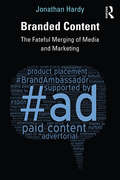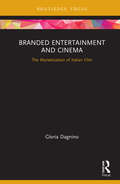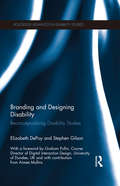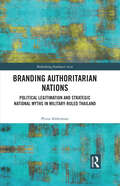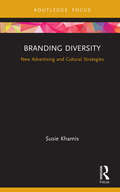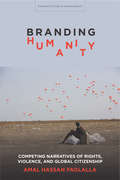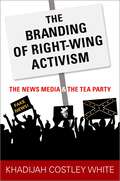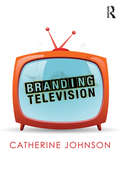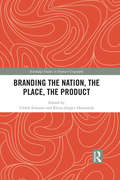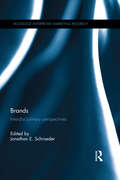- Table View
- List View
Branded Content: The Fateful Merging of Media and Marketing
by Jonathan HardyThis is a critical study of the changing relationship between media and marketing communications in the digital age. It examines the growth of content funded by brands, including brands’ own media, native advertising, and the integration of branded content across film, television, journalism and publishing, online, mobile, and social media. This ambitious historical, empirical, and theoretical study examines industry practices, policies, and ‘problems’, advancing a framework for analysis of communications governance. Featuring examples from the UK, US, EU, Asia, and other regions, it illustrates and explains industry practices, forms, and formats and their relationship with changing market conditions, policies, and regulation. The book provides a wide-ranging and incisive guide to contemporary advertising and media practices, to different arguments and perspectives on these practices arising in industry, policy, and academic contexts, and to the contribution made by critical scholarship, past and present. It also offers a critical review of industry, regulatory, societal, and academic literatures.Jonathan Hardy examines the erosion of the principle of separating advertising and media and calls for a new framework for distinguishing marketing communications across 21st-century communications. With a focus on key issues in industry, policy, and academic contexts, this is essential reading for students of media industries, advertising, marketing, and digital media.
Branded Content: The Fateful Merging of Media and Marketing
by Jonathan HardyThis is a critical study of the changing relationship between media and marketing communications in the digital age. It examines the growth of content funded by brands, including brands’ own media, native advertising, and the integration of branded content across film, television, journalism and publishing, online, mobile, and social media. This ambitious historical, empirical, and theoretical study examines industry practices, policies, and ‘problems’, advancing a framework for analysis of communications governance. Featuring examples from the UK, US, EU, Asia, and other regions, it illustrates and explains industry practices, forms, and formats and their relationship with changing market conditions, policies, and regulation. The book provides a wide-ranging and incisive guide to contemporary advertising and media practices, to different arguments and perspectives on these practices arising in industry, policy, and academic contexts, and to the contribution made by critical scholarship, past and present. It also offers a critical review of industry, regulatory, societal, and academic literatures.Jonathan Hardy examines the erosion of the principle of separating advertising and media and calls for a new framework for distinguishing marketing communications across 21st-century communications. With a focus on key issues in industry, policy, and academic contexts, this is essential reading for students of media industries, advertising, marketing, and digital media.
Branded Entertainment and Cinema: The Marketisation of Italian Film (Routledge Critical Advertising Studies)
by Gloria DagninoThe history of Italian cinema is mostly regarded as a history of Italian auteurs. This book takes a different standpoint, looking at Italian cinema from the perspective of an unusual, but influential actor: advertisers. From the iconic Vespa scooter and the many other Made in Italy products placed in domestic and international features, to Carosello’s early format of branded entertainment, up through the more recent brand integration cases in award-winning titles like The Great Beauty, the Italian film and advertising industries have frequently and significantly intersected, in ways that remain largely unexplored by academic research. This book contributes to fill this gap, by focusing on the economic and cultural influence that advertising and advertisers’ interests have been exerting on Italian film production between the post-war period and the 2010s. Increasingly market-oriented film policies, ongoing pressure from Hollywood competition, and the abnormal economic as well as political power held by Italian ad-funded broadcasters are among the key points addressed by the book. In addition to a macro-level political economic analysis, the book draws on exclusive interviews with film producers and promotional intermediaries to provide a meso level analysis of the practices and professional cultures of those working at the intersection of Italian film and advertising industries. Providing an in-depth yet clear and accessible overview of the political and economic dynamics driving the Italian media landscape towards unprecedented forms of marketisation, this is a valuable resource for academics and students in the fields of film and media studies, marketing, advertising, and Italian studies.
Branded Entertainment and Cinema: The Marketisation of Italian Film (Routledge Critical Advertising Studies)
by Gloria DagninoThe history of Italian cinema is mostly regarded as a history of Italian auteurs. This book takes a different standpoint, looking at Italian cinema from the perspective of an unusual, but influential actor: advertisers. From the iconic Vespa scooter and the many other Made in Italy products placed in domestic and international features, to Carosello’s early format of branded entertainment, up through the more recent brand integration cases in award-winning titles like The Great Beauty, the Italian film and advertising industries have frequently and significantly intersected, in ways that remain largely unexplored by academic research. This book contributes to fill this gap, by focusing on the economic and cultural influence that advertising and advertisers’ interests have been exerting on Italian film production between the post-war period and the 2010s. Increasingly market-oriented film policies, ongoing pressure from Hollywood competition, and the abnormal economic as well as political power held by Italian ad-funded broadcasters are among the key points addressed by the book. In addition to a macro-level political economic analysis, the book draws on exclusive interviews with film producers and promotional intermediaries to provide a meso level analysis of the practices and professional cultures of those working at the intersection of Italian film and advertising industries. Providing an in-depth yet clear and accessible overview of the political and economic dynamics driving the Italian media landscape towards unprecedented forms of marketisation, this is a valuable resource for academics and students in the fields of film and media studies, marketing, advertising, and Italian studies.
Branded Male: Marketing to Men
by Mark TungateThe male market is exploding. Thanks to emerging social and cultural trends, men are becoming consumers to reckon with. In 1990 only 4% of men claimed to regularly use a skin care product. By 2015 the figure will have risen to 50%.Branded Male discusses the evolution of the male consumer and the desire of marketers to tap into the still underdeveloped male market. Crammed with facts and anecdotes, it analyzes how to effectively brand products and services for the male market. Using a typical modern male's weekday as a template and examining all the influences affecting him, Branded Male considers his exposure to brands and the ways marketers can exploit these channels, taking you through popular strategies for marketing to men.In his trademark style, Mark Tungate paints a portrait of the male consumer. From razor blades to beer, from aftershave to hotels, he finds out which marketing messages have the most impact on male wallets. Men's bank balances may never be the same again.
Branding and Designing Disability: Reconceptualising Disability Studies (Routledge Advances in Disability Studies)
by Elizabeth DePoy Stephen GilsonOver the past fifty years, design and branding have become omnipotent in the market and have made their way to other domains as well. Given their potential to divide humans into categories and label their worth and value, design and branding can wield immense but currently unharnessed powers of social change. Groups designed as devalued can be undesigned, redesigned and rebranded to seamlessly and equivalently participate in community, work and civic life. This innovative book argues that disability as a concept and category is created, reified, and segregated through current design and branding that begs for creative change. Transcending models of disability that locate it either as an embodied medical condition or as a socially constructed entity, this book challenges the very existence and usefulness of the category itself. Proposing and illustrating creative and responsible design, DePoy and Gilson include thinking and action strategies that are useful and potent for "undesigning", redesigning, and rebranding to meet the full range of human needs and to enhance full participation in local through global communities. Divided into two parts, the first section presents a critical examination of disability as a designed and branded phenomenon, exploring what exactly is being designed and branded and how. The second part investigates the redesign of disability and provides principles for redesign and rebranding illustrated with examples from high-tech to place-based sustainable strategies. The book provides a unique and contemporary framework for thinking about disability as well as providing relevant design and branding guidance to designers and engineers interested in embodiment issues.
Branding and Designing Disability: Reconceptualising Disability Studies (Routledge Advances in Disability Studies)
by Elizabeth DePoy Stephen GilsonOver the past fifty years, design and branding have become omnipotent in the market and have made their way to other domains as well. Given their potential to divide humans into categories and label their worth and value, design and branding can wield immense but currently unharnessed powers of social change. Groups designed as devalued can be undesigned, redesigned and rebranded to seamlessly and equivalently participate in community, work and civic life. This innovative book argues that disability as a concept and category is created, reified, and segregated through current design and branding that begs for creative change. Transcending models of disability that locate it either as an embodied medical condition or as a socially constructed entity, this book challenges the very existence and usefulness of the category itself. Proposing and illustrating creative and responsible design, DePoy and Gilson include thinking and action strategies that are useful and potent for "undesigning", redesigning, and rebranding to meet the full range of human needs and to enhance full participation in local through global communities. Divided into two parts, the first section presents a critical examination of disability as a designed and branded phenomenon, exploring what exactly is being designed and branded and how. The second part investigates the redesign of disability and provides principles for redesign and rebranding illustrated with examples from high-tech to place-based sustainable strategies. The book provides a unique and contemporary framework for thinking about disability as well as providing relevant design and branding guidance to designers and engineers interested in embodiment issues.
Branding Authoritarian Nations: Political Legitimation and Strategic National Myths in Military-Ruled Thailand (Rethinking Southeast Asia)
by Petra AldermanBranding Authoritarian Nations offers a novel approach to the study of nation branding as a strategy for political legitimation in authoritarian regimes using the example of military-ruled Thailand. The book argues that nation branding is a political act that is integral to state legitimation processes, particularly in the context of authoritarian regimes. It applies its alternative reading of nation branding to eight different sectors: tourism, economy, foreign direct investment, foreign policy, education, culture, public relations, and the private sector. The author explains that nation branding produces specific kinds of applied national myths, referred to as ‘strategic national myths.’ She shows that nation branding is an inherently inward-looking strategy aimed at shaping the social attitudes and behaviours of the nation’s citizens in line with the government’s domestic agenda and legitimation needs. Providing the first comprehensive analysis of nation branding in Thailand and the first book-length account of the country’s political developments since the 2014–2019 military rule, the book is primarily aimed at academics in the disciplines of politics, international relations, communication, and area studies as well as business, cultural, and intercultural studies.
Branding Authoritarian Nations: Political Legitimation and Strategic National Myths in Military-Ruled Thailand (Rethinking Southeast Asia)
by Petra AldermanBranding Authoritarian Nations offers a novel approach to the study of nation branding as a strategy for political legitimation in authoritarian regimes using the example of military-ruled Thailand. The book argues that nation branding is a political act that is integral to state legitimation processes, particularly in the context of authoritarian regimes. It applies its alternative reading of nation branding to eight different sectors: tourism, economy, foreign direct investment, foreign policy, education, culture, public relations, and the private sector. The author explains that nation branding produces specific kinds of applied national myths, referred to as ‘strategic national myths.’ She shows that nation branding is an inherently inward-looking strategy aimed at shaping the social attitudes and behaviours of the nation’s citizens in line with the government’s domestic agenda and legitimation needs. Providing the first comprehensive analysis of nation branding in Thailand and the first book-length account of the country’s political developments since the 2014–2019 military rule, the book is primarily aimed at academics in the disciplines of politics, international relations, communication, and area studies as well as business, cultural, and intercultural studies.
Branding Berlin: From Division to the Cultural Capital of Europe (Routledge Research in Cultural and Media Studies)
by Katrina SarkThis book is a cultural history of post-Wall urban, social, political, and cultural transformations in Berlin. Branding Berlin: From Division to the Cultural Capital of Europe presents a cultural analysis of Berlin’s cultural production, including literature, film, memoirs and non-fiction works, art, media, urban branding campaigns, and cultural diversity initiatives put forth by the Berlin Senate, and allows readers to understand the various changes that transformed the formerly divided city of voids into a hip cultural capital. The book examines Berlin’s branding, urban-economic development, and its search for a post-Wall identity by focusing on manifestations of nostalgic longing in documentary films and other cultural products. Building on the sociological research of urban branding and linking it with an interpretive analysis of cultural products generated in Berlin during that time, the author examines the intersections and tensions between the nostalgic views of the past and the branded images of Berlin’s present and future. This insightful and innovative work will interest scholars and students of cultural and media studies, branding and advertising, urban communication, film studies, visual culture, tourism, and cultural memory.
Branding Berlin: From Division to the Cultural Capital of Europe (Routledge Research in Cultural and Media Studies)
by Katrina SarkThis book is a cultural history of post-Wall urban, social, political, and cultural transformations in Berlin. Branding Berlin: From Division to the Cultural Capital of Europe presents a cultural analysis of Berlin’s cultural production, including literature, film, memoirs and non-fiction works, art, media, urban branding campaigns, and cultural diversity initiatives put forth by the Berlin Senate, and allows readers to understand the various changes that transformed the formerly divided city of voids into a hip cultural capital. The book examines Berlin’s branding, urban-economic development, and its search for a post-Wall identity by focusing on manifestations of nostalgic longing in documentary films and other cultural products. Building on the sociological research of urban branding and linking it with an interpretive analysis of cultural products generated in Berlin during that time, the author examines the intersections and tensions between the nostalgic views of the past and the branded images of Berlin’s present and future. This insightful and innovative work will interest scholars and students of cultural and media studies, branding and advertising, urban communication, film studies, visual culture, tourism, and cultural memory.
Branding Center: Über den Einfluss globaler Markenkonzerne auf die Innenstädte
by Frank RoostGlobal agierende Markenkonzerne errichten immer häufiger Showrooms, Flagship Stores und Firmenmuseen, die ihnen als dreidimensionale Werbung dienen. Vor allem in den Metropolen prägen solche als Branding Center bezeichneten Bauten zunehmend das Stadtbild. Am Beispiel von Projekten der Sony Corporation in Berlin, San Francisco und Tokyo untersucht der Autor, wie die globalen Marketingstrategien der Konzerne und die lokalen planerischen Konzepte bei dieser neuen Form der Stadtproduktion zusammenwirken. Dabei stellt er den Zusammenhang mit dem globalisierungsbedingten Wandel der Produktions- und Konsummuster dar, bestimmt den Stellenwert der imageorientierten Investitionen für die Stadtentwicklung und zeigt die Handlungsspielräume im planerischen Umgang mit den Branding Centern.
Branding Diversity: New Advertising and Cultural Strategies (Routledge Critical Advertising Studies)
by Susie KhamisBranding Diversity considers how brands both reflect and affect contemporary discussions of cultural diversity. Advancing an innovative, critical perspective on advertising, the book challenges the latent assumption that advertisers are inherently conservative and reluctant to represent anything other than popularly agreeable scripts and narratives. On the contrary, advertising is now replete with progressive messaging. Through Budweiser, Gillette, Vogue and Patagonia, Susie Khamis demonstrates that such forays into the political realm are not just shrewd appraisals of popular causes, but also inevitable outcomes of contemporary media and politics. This book will be of interest to scholars in advertising studies, marketing communications and media studies.
Branding Diversity: New Advertising and Cultural Strategies (Routledge Critical Advertising Studies)
by Susie KhamisBranding Diversity considers how brands both reflect and affect contemporary discussions of cultural diversity. Advancing an innovative, critical perspective on advertising, the book challenges the latent assumption that advertisers are inherently conservative and reluctant to represent anything other than popularly agreeable scripts and narratives. On the contrary, advertising is now replete with progressive messaging. Through Budweiser, Gillette, Vogue and Patagonia, Susie Khamis demonstrates that such forays into the political realm are not just shrewd appraisals of popular causes, but also inevitable outcomes of contemporary media and politics. This book will be of interest to scholars in advertising studies, marketing communications and media studies.
Branding Humanity: Competing Narratives of Rights, Violence, and Global Citizenship (Stanford Studies in Human Rights)
by Amal Hassan FadlallaThe Save Darfur movement gained an international following, garnering widespread international attention to this remote Sudanese territory. Celebrities and other notable public figures participated in human rights campaigns to combat violence in the region. But how do local activists and those throughout the Sudanese diaspora in the United States situate their own notions of rights, nationalism, and identity? Based on interviews with Sudanese social actors, activists, and their allies in the United States, the Sudan, and online, Branding Humanity traces the global story of violence and the remaking of Sudanese identities. Amal Hassan Fadlalla examines how activists contest, reshape, and reclaim the stories of violence emerging from the Sudan and their identities as migrants. Fadlalla charts the clash and friction of the master-narratives and counter-narratives circulated and mobilized by competing social and political actors negotiating social exclusion and inclusion through their own identity politics and predicament of exile. In exploring the varied and individual experiences of Sudanese activists and allies, Branding Humanity helps us see beyond the oft-monolithic international branding of conflict. Fadlalla asks readers to consider how national and transnational debates about violence circulate, shape, and re-territorialize ethnic identities, disrupt meanings of national belonging, and rearticulate notions of solidarity and global affiliations.
The Branding of Right-Wing Activism: The News Media and the Tea Party
by Khadijah Costley WhiteFrom the start of Barack Obama's presidency in 2009, conservative populist groups began fomenting political fractiousness, dissent, and surprising electoral success. The Tea Party was one of the major characters driving this story. But, as Khadijah Costley White argues in this book, the Tea Party's ascent to major political phenomenon can be attributed to the way in which partisan and non-partisan news outlets "branded" the Party as a pot-stirrer in political conflicts over race, class, and gender. In other words, the news media played a major role in developing, cultivating, and promoting populism's brand, particularly within the news spaces of commentary and opinion. Through the language of political marketing, branding, and promotion, the news media not only reported on the Tea Party, but also acted as its political strategist and brand consultant. Moreover, the conservative press acted more as a political party than a news medium, deliberately promoting the Tea Party, and aiding in organizing, headlining, and galvanizing a conservative political base around specific Tea Party candidates, values, and events. In a media environment in which everyone has the opportunity to tune out, tune in, and speak back, The Branding of Right-Wing Activism ultimately shows that distinctions between citizens, journalists, activists, politicians, celebrities, and consumers are more symbolic than concrete.
BRANDING OF RIGHT-WING ACTIVISM C: The News Media and the Tea Party
by Khadijah Costley WhiteFrom the start of Barack Obama's presidency in 2009, conservative populist groups began fomenting political fractiousness, dissent, and surprising electoral success. The Tea Party was one of the major characters driving this story. But, as Khadijah Costley White argues in this book, the Tea Party's ascent to major political phenomenon can be attributed to the way in which partisan and non-partisan news outlets "branded" the Party as a pot-stirrer in political conflicts over race, class, and gender. In other words, the news media played a major role in developing, cultivating, and promoting populism's brand, particularly within the news spaces of commentary and opinion. Through the language of political marketing, branding, and promotion, the news media not only reported on the Tea Party, but also acted as its political strategist and brand consultant. Moreover, the conservative press acted more as a political party than a news medium, deliberately promoting the Tea Party, and aiding in organizing, headlining, and galvanizing a conservative political base around specific Tea Party candidates, values, and events. In a media environment in which everyone has the opportunity to tune out, tune in, and speak back, The Branding of Right-Wing Activism ultimately shows that distinctions between citizens, journalists, activists, politicians, celebrities, and consumers are more symbolic than concrete.
Branding Television (Comedia)
by Catherine JohnsonBranding Television examines why and how the UK and US television industries have turned towards branding as a strategy in response to the rise of satellite, cable and digital television, and new media, such as the internet and mobile phone. This is the first book to offer a sustained critical analysis of this new cultural development. Branding Television examines the industrial, regulatory and technological changes since the 1980s in the UK and the USA that have led to the adoption of branding as broadcasters have attempted to manage the behaviour of viewers and the values associated with their channels, services and programmes in a world of increased choice and interactivity. Wide-ranging case studies drawn from commercial, public service, network and cable/satellite television (from NBC and HBO to MTV, and from BBC and Channel 4 to UKTV and Sky) analyse the role of marketing and design in branding channels and corporations, and the development of programmes as brands. Exploring both successful and controversial uses of branding, this book asks what problems there are in creating television brands and whether branding supports or undermines commercial and public service broadcasting. Branding Television extends and complicates our understanding of the changes to television over the past 30 years and of the role of branding in contemporary Western culture. It will be of particular interest to students and researchers in television studies, but also in creative industries and media and cultural studies more generally.
Branding Television (Comedia)
by Catherine JohnsonBranding Television examines why and how the UK and US television industries have turned towards branding as a strategy in response to the rise of satellite, cable and digital television, and new media, such as the internet and mobile phone. This is the first book to offer a sustained critical analysis of this new cultural development. Branding Television examines the industrial, regulatory and technological changes since the 1980s in the UK and the USA that have led to the adoption of branding as broadcasters have attempted to manage the behaviour of viewers and the values associated with their channels, services and programmes in a world of increased choice and interactivity. Wide-ranging case studies drawn from commercial, public service, network and cable/satellite television (from NBC and HBO to MTV, and from BBC and Channel 4 to UKTV and Sky) analyse the role of marketing and design in branding channels and corporations, and the development of programmes as brands. Exploring both successful and controversial uses of branding, this book asks what problems there are in creating television brands and whether branding supports or undermines commercial and public service broadcasting. Branding Television extends and complicates our understanding of the changes to television over the past 30 years and of the role of branding in contemporary Western culture. It will be of particular interest to students and researchers in television studies, but also in creative industries and media and cultural studies more generally.
Branding the Nation, the Place, the Product (Routledge Studies in Human Geography)
by Ulrich Ermann Klaus-Jürgen HermanikBranding is a profoundly geographical type of commodification process. Many things become commodities that are compared and valuated on markets around the globe. Places such as cities or regions, countries and nations attempt to acquire visibility through branding. Geographical imaginations are evoked to brand goods and places as commodities in order to show or create connections and add value. Yet, not all that is branded was originally intended and created for markets. This volume aims to broaden current understanding of branding through a series of contributions from geography, history, political studies, cultural, and media studies, offering insight into how ordinary places, objects and practices become commodities through branding. In so doing, the contributions also show how nation, place and product as targets of branding can be seen as intertwined. To discuss these forms of branding, book chapters refer to states, cities, holiday destinations, food malls, movies, dances, post stamps and other items that serve as brands and/or are branded. The book will be of interest to students and scholars in geography, sociology, history, cultural studies and business studies who would like to gain an understanding of the intricate and surprising ways in which things, places, and cultural practices become brands.
Branding the Nation, the Place, the Product (Routledge Studies in Human Geography)
by Ulrich Ermann Klaus-Jürgen HermanikBranding is a profoundly geographical type of commodification process. Many things become commodities that are compared and valuated on markets around the globe. Places such as cities or regions, countries and nations attempt to acquire visibility through branding. Geographical imaginations are evoked to brand goods and places as commodities in order to show or create connections and add value. Yet, not all that is branded was originally intended and created for markets. This volume aims to broaden current understanding of branding through a series of contributions from geography, history, political studies, cultural, and media studies, offering insight into how ordinary places, objects and practices become commodities through branding. In so doing, the contributions also show how nation, place and product as targets of branding can be seen as intertwined. To discuss these forms of branding, book chapters refer to states, cities, holiday destinations, food malls, movies, dances, post stamps and other items that serve as brands and/or are branded. The book will be of interest to students and scholars in geography, sociology, history, cultural studies and business studies who would like to gain an understanding of the intricate and surprising ways in which things, places, and cultural practices become brands.
Brands: Meaning and Value in Media Culture
by Adam ArvidssonDrawing on rich empirical material, this revealing book builds up a critical theory, arguing that brands have become an important tool for transforming everyday life into economic value. When branding lifestyles or value complexes onto their products, companies assume that consumers desire products for their ability to give meaning to their lives. Yet, brands also have a key function within managerial strategy. Examining the history of audience and market research, marketing thought and advertising strategy; the first part of this book traces the historical development of branding, whilst the second part evaluates new media, contemporary management and overall media economics to present the first systematic theory of brands: the brand as a key institution in information capitalism. It includes chapters on: consumption marketing brand management online branding the brand as informational capital. Richly illustrated with case studies from market research, advertising, shop displays, mobile phones, the internet and virtual companies, this outstanding book is essential reading for students and researchers of the sociology of media, cultural studies, advertising and consumer studies and marketing.
Brands: Meaning and Value in Media Culture
by Adam ArvidssonDrawing on rich empirical material, this revealing book builds up a critical theory, arguing that brands have become an important tool for transforming everyday life into economic value. When branding lifestyles or value complexes onto their products, companies assume that consumers desire products for their ability to give meaning to their lives. Yet, brands also have a key function within managerial strategy. Examining the history of audience and market research, marketing thought and advertising strategy; the first part of this book traces the historical development of branding, whilst the second part evaluates new media, contemporary management and overall media economics to present the first systematic theory of brands: the brand as a key institution in information capitalism. It includes chapters on: consumption marketing brand management online branding the brand as informational capital. Richly illustrated with case studies from market research, advertising, shop displays, mobile phones, the internet and virtual companies, this outstanding book is essential reading for students and researchers of the sociology of media, cultural studies, advertising and consumer studies and marketing.
Brands: Interdisciplinary Perspectives (Routledge Interpretive Marketing Research)
by Jonathan E. SchroederBranding has emerged as a cornerstone of marketing practice and corporate strategy, as well as a central cultural practice. In this book, Jonathan Schroeder brings together a curated selection of the most influential and thought-provoking papers on brands and branding from Consumption Markets and Culture, accompanied by new contributions from leading brand scholars Giana Eckhardt, John F. Sherry, Jr., Sidney Levy and Morris Holbrook. Organised into four perspectives – cultural, corporate, consumer, critical - these papers are chosen to highlight the complexities of contemporary branding through leading consumer brands such as Disney, eBay, Guinness, McDonalds, Nike, and Starbucks. They address key topics such as celebrity branding, corporate branding, place branding, and retail branding and critique the complexities of contemporary brands to provide a rich trove of interdisciplinary research insights into the function of brands as ethical, ideological and political objects. This thought-provoking collection will be of interest to all scholars of marketing, consumer behaviour, anthropology and sociology, and anyone interested in the powerful roles brands play in consumer’s lives and cultural discourse.
Brands: Interdisciplinary Perspectives (Routledge Interpretive Marketing Research)
by Jonathan E. SchroederBranding has emerged as a cornerstone of marketing practice and corporate strategy, as well as a central cultural practice. In this book, Jonathan Schroeder brings together a curated selection of the most influential and thought-provoking papers on brands and branding from Consumption Markets and Culture, accompanied by new contributions from leading brand scholars Giana Eckhardt, John F. Sherry, Jr., Sidney Levy and Morris Holbrook. Organised into four perspectives – cultural, corporate, consumer, critical - these papers are chosen to highlight the complexities of contemporary branding through leading consumer brands such as Disney, eBay, Guinness, McDonalds, Nike, and Starbucks. They address key topics such as celebrity branding, corporate branding, place branding, and retail branding and critique the complexities of contemporary brands to provide a rich trove of interdisciplinary research insights into the function of brands as ethical, ideological and political objects. This thought-provoking collection will be of interest to all scholars of marketing, consumer behaviour, anthropology and sociology, and anyone interested in the powerful roles brands play in consumer’s lives and cultural discourse.
